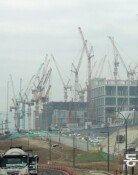Seouls Population to Decrease Starting 2013
Seouls Population to Decrease Starting 2013
Posted April. 26, 2005 23:29,
The number of people living in Seoul is expected to decrease to fewer than 10 million around 2019 after the start of a downtrend in the number of people starting in 2013.
In addition, as Korea has become an aging society at a rapid rate, it is forecasted that Korea will become a super-aged society, with one out of five people over 65 years old in 2026.
The Korea Statistics Office (NSO) announced its Results of a special estimate of the future population in each city and province, including the above-mentioned contents.
Seoul, Its Not a Jam-Packed City Anymore-
According to the estimate, the population of Seoul will hit its peak in 2012 with a population of about 10.08 million, but will start to fall starting 2013 with a population of 10.06 million, and eventually decrease to 9.98 million in 2019.
This means that considering the fact that the whole population of 49.95 million people will decline starting 2021, a downward tendency in the population of Seoul will eventually start eight years ahead of the nations average.
If the population of Seoul in 2019 drops to under 10 million people, it will be the first time the number of people in the area has dropped to under 10 million people in 32 years since 1987 (9.93 million people).
Jeong Chang-shin, a manager in the population census division of the NSO explained the reason of fall in the number of people in Seoul by saying, The population clustered in Seoul is moving out to outer regions.
Consequently, the population of the areas close to Seoul, including Gyeonggi, Chungnam, and Daejeon, will increase by 2030.
The population of Gyeonggi Province will grow by 25.8 percent to 13.47 million people, compared with 10.71 million people this year.
The ratio of the population of the metropolitan area, which is expected to accounts for over 50 percent in 2011, is attributable to the huge influx of people into Gyeonggi Province.
The populations of Chungnam and Daejeon will swell by 10 percent and 8.9 percent, respectively, from 2005 to 2020.
The NSO noted that if the movement of new administrative capital is taken into account, the population of Seoul could fall at a faster rate, and the population of Chungnam could rise even more.
Korea to Become a Super-Aged Society In 2026-
Under the U.Ns classification standard for types of population, if people aged 65 and over account for over seven percent of the whole population in a country, the country is considered to be an aging society. If a country has a ratio of over 14 percent for people aged 65 and over, it is classified as an aged society, and with a ratio of over 20 percent, it is called a super-aged society.
The NSO forecasts that Korea will become a super-aged society in 2026 after becoming an aged society in 2018.
If this happens, the risk emerges that labor productivity could drop because the ratio of people aged from 15 to 64, classified as the productive population, decreases from 71.8 percent in 2005 to 64.7 percent in 2030.
The expected ratio of productive population, according to each city and province in 2030, has a wide gap from place to place, with Seoul (66.9 percent), Daejeon (66.8 percent), Gyeonggi (66.7 percent), Jeonnam (55.7 percent), Jeonbuk (58.0 percent), and Gyeongbuk (59.2 percent).
Moon Hyeong-pyo, senior researcher of the Korean Development Institute, said that the potential growth rate could shrink due to a fall in productivity per person and in the number of people who are saving from the aging in the country, and that Korea should actively make the most of female labor.
legman@donga.com







